Jackfruit or Breadfruit: Which Tropical Fruit Wins?
Jackfruit and breadfruit might seem like cousins in the tropical fruit family, yet each brings unique flavors to the table.
Large, textured fruits have captured attention across various cuisines worldwide for centuries.
Both impressive in size, they can transform ordinary meals into extraordinary culinary experiences.
Jackfruit offers a sweet, fruity taste when ripe, while its unripe version works wonderfully as a meat substitute.
Native to Southeast Asia, this versatile food now appears in dishes from pulled "pork" sandwiches to sweet desserts.
People often confuse these fruits due to their similar appearance and names, but knowing their distinct characteristics helps choose the right one for specific recipes.
Jackfruit Secrets Everyone Should Know
Jackfruit trees thrive in tropical regions, producing massive fruits that can weigh up to 120 pounds and measure over 20 inches across. Native to areas between Southern India, Sri Lanka, Bangladesh (where it's the national fruit), and Southeast Asian rainforests, these remarkable trees now grow throughout Brazil and Southeast Asia as well.
A single mature tree can yield about 200 enormous fruits annually, making jackfruit an economically valuable crop for people living in lowland tropical areas. The fruit itself offers amazing versatility - when ripe, it delivers a sweet taste with a distinctive aroma perfect for eating fresh or dried as dessert.
Green, unripe jackfruit serves as a popular vegetarian meat alternative in many cuisines. From the Moraceae family (related to mulberries and figs), this incredible fruit brings both delicious flavors and practical benefits to tropical communities around the world.
Breadfruit’s Tasty Facts You’ve Never Heard
Breadfruit gets its name from its unique texture when cooked. Most people need to cook this fruit before eating it, though very ripe ones can be consumed raw.
Many compare its flavor to potatoes, and the interior resembles bread when cut open.
Some specimens can reach impressive sizes, with the largest weighing around 13 pounds.
This flowering plant belongs to the Moraceae family alongside jackfruit, originating from New Guinea, the Philippines, and the Maluku Islands as a descendant of the breadnut (Artocarpus camansi).
Today, breadfruit thrives in over 90 countries across tropical areas including Southeast Asia, Pacific islands, and parts of Africa.
People worldwide value this remarkable fruit as a major food source and agricultural product.
Jackfruit vs Breadfruit: The Comparison
Jackfruit and breadfruit share such a strong resemblance that people often mix them up, despite not knowing they belong to the same botanical family. Below is our comparison table highlights key differences to help you tell them apart.
| Aspect | Jackfruit | Breadfruit |
| Origin | Native to India; name derives from Portuguese "jaca," from South Indian "chakka pazham." Also known as kanun (Thailand), kathal (Bangladesh), nangka (Malaysia). | Originated in South Pacific (Indonesia, Malaysia, New Guinea). Spread across the Pacific ~3000 BC. Now grown in ~100 countries. |
| Growing Region | Tropical/subtropical Asia, South America, Australia, Africa, Pacific Islands, Hawaii, Florida. Often found on streets or mixed orchards, not usually commercial farms. | Grows in equatorial lowlands (21-32ºC, 600-650m elevation). Common in South Florida, Caribbean, Hawaii, Pacific Islands, Africa, South/Southeast Asia. |
| Appearance | Largest fruit worldwide, elongated and plump, rough spiky rind (green/yellow/brown). Yellow flesh surrounds large brown seeds; core is latex-filled. | Smaller, melon-sized, round or oblong with thorny but less sharp rind (green/yellow/brown). White or pale yellow flesh; may have seeds or be seedless. |
| Taste | Sweet tropical flavor, ripe fruit aromatic with soft or slightly fibrous texture; unripe is bland. | Needs cooking; tastes starchy like potato or bread. Flesh is firm, becomes sweeter when ripe. Used boiled, steamed, in soups or as flour. |
| Nutrition | High vitamin C, antioxidants, vitamin A, fiber; supports immunity, eye health, digestion, and may reduce cancer risk. | Gluten-free starchy food, rich in fiber, protein, essential amino acids, vitamin C, carotenoids, and antioxidants that protect skin and promote cell growth. |
Origin
Jackfruit originates from India, with its name tracing back to the Portuguese word “jaca,” which itself comes from the South Indian term “chakka pazham.” This fruit is known by different names across Asia, including kanun in Thailand, kathal in Bangladesh, and nangka in Malaysia. Breadfruit, on the other hand, has roots in the South Pacific region, Indonesia, Malaysia, and New Guinea, and spread widely throughout the Pacific islands around 3000 BC.
Europeans discovered breadfruit in the late 1500s, and today it is grown in nearly 100 countries worldwide.
Growing Region
Jackfruit thrives in tropical and subtropical climates and is commonly found in South and Southeast Asia, parts of South America, Africa, Australia, the Pacific Islands, and in warmer U.S. states like Hawaii and southern Florida.
It often grows wild or along streets rather than in commercial orchards. Breadfruit adapts well to a range of tropical conditions, favoring lowland areas with moderate elevation and temperatures between 21 and 32 degrees Celsius.
It is widely cultivated in the Caribbean, South Florida, Pacific Islands, Africa, and parts of Asia.
Appearance
Jackfruit is known as the largest fruit in the world, typically elongated and bulky, with a thick, spiky outer shell that changes from green to yellow or brown as it ripens. Inside, it has bright yellow flesh surrounding large brown seeds, and a sticky latex core that must be removed before eating.
Breadfruit is smaller, roughly the size of a melon, and shaped round or oval. Its skin is thorny but less sharp than jackfruit’s, varying in green, yellow, or brown tones.
The flesh inside is usually white or pale yellow, and some varieties have seeds while others do not.
Taste
Jackfruit offers a distinct tropical sweetness reminiscent of fruits like mango and pineapple when ripe, with a soft, sometimes fibrous texture; unripe jackfruit is nearly tasteless. Breadfruit must be cooked before eating and has a starchy flavor similar to potatoes or freshly baked bread.
Its flesh is firm and becomes sweeter as it ripens, making it a versatile ingredient used boiled, steamed, roasted, or ground into flour for various dishes.
Nutritional Value
Jackfruit is a nutrient-rich fruit packed with vitamin C, antioxidants, vitamin A, and dietary fiber, which support immune health, eye function, digestion, and may help reduce cancer risks. Breadfruit serves as a gluten-free starchy food high in fiber, protein, essential amino acids, and vitamin C.
How to Store Jackfruit and Breadfruit
Storing ripe jackfruits and breadfruit is quite different. Check out the table below for details.
| Storage Aspect | Jackfruit | Breadfruit |
| Whole Fruit | Store uncut jackfruit in a cool, dry place at room temperature; lasts several days. | Keep whole breadfruit at room temperature until ripe (a few days). |
| After Ripening | Once cut, wrap flesh tightly or use airtight containers; refrigerate up to 1 week. | Once ripe, use soon or refrigerate to slow ripening and extend freshness for a few days. |
| Cut or Cooked | Refrigerate cut flesh in airtight containers; eat within a week. | Store cut or cooked breadfruit in airtight containers; consume within 3–4 days. |
| Freezing | Freeze jackfruit flesh in sealed bags/containers for several months; retains flavor well. | Cook first (boil/roast), then freeze in sealed bags/containers for later use. |
| Odor Absorption | Avoid storing near strong-smelling foods, as jackfruit can absorb odors. | Not specifically sensitive to odors but store properly in airtight containers. |
Storing Jackfruit
Fresh jackfruit should be stored in a cool, dry place if uncut and can last for several days at room temperature. Once cut, wrap the edible flesh tightly in plastic wrap or place it in an airtight container and refrigerate.
The cut jackfruit pulp can stay fresh in the fridge for up to a week. For longer storage, jackfruit flesh freezes well - place it in sealed freezer bags or containers, where it can keep for several months without losing much flavor or texture.
Avoid storing jackfruit with strong-smelling foods, as it can absorb odors.
Storing Breadfruit
Whole breadfruit should be kept at room temperature until it ripens, which usually takes a few days. Once ripe, it becomes softer and sweeter, so use it soon after ripening.
For short-term storage, keep breadfruit in the refrigerator to slow ripening and extend freshness by a few days. Cut or cooked breadfruit should be stored in an airtight container in the fridge and eaten within 3–4 days.
Breadfruit also freezes well, cook it first (boil or roast), then freeze portions in sealed bags or containers for later use.
What Dishes to Create with Jackfruit and Breadfruit?
Jackfruit and breadfruit show up in many tasty recipes worth sampling for yourself. With just a few tips, you can master cooking with these fruits and expand your food horizons beyond the ordinary.
Jackfruit Jam
Preparing jackfruit jam takes just 60 minutes from start to finish, making it perfect for anyone who wants a quick homemade treat. For beginners in the kitchen, this recipe comes as a relief since it needs only four basic ingredients and follows straightforward steps.
The key to success lies in selecting completely ripe jackfruit, though canned options work well as a convenient alternative. Many people love how this spread offers natural sweetness without requiring loads of added sugar, which means you can enjoy it as a healthier option for breakfast or snacks.
The final result gives you a delicious, fruity jam that tastes much better than store-bought varieties.
Jackfruit Curry
Whip up a delicious jackfruit curry in just 1 hour and 5 minutes that rivals traditional Indian favorites. Our recipe swaps regular milk for coconut milk, adding wonderful depth and richness to each spoonful.
For anyone seeking meat-like texture in vegetarian meals, young, unripe jackfruit works perfectly as a chicken substitute. Many people can't tell the difference when the curry is served, making this dish an excellent way to enjoy classic Indian flavors without meat.
The natural texture of jackfruit absorbs all the aromatic spices beautifully, creating a satisfying meal that both vegetarians and meat-eaters will love.
Sriracha Jackfruit Bowl
Jackfruit can shine in many tasty dishes beyond the usual suspects. This easy burrito recipe takes just 40 minutes from start to finish, making it perfect for weeknight family meals.
Kids and adults will love wrapping the savory jackfruit filling in warm tortillas, then adding their favorite toppings. The recipe works well with both canned and fresh jackfruit, depending on what's available near you.
For those who enjoy some heat, an extra drizzle of sriracha sauce adds the perfect kick without overwhelming the natural flavors of this amazing fruit.
Caribbean Breadfruit Puffs
Ready in just 45 minutes, this easy breadfruit recipe deserves a spot in your collection. Ripe breadfruit works best for its natural sweetness, while Bonnet pepper adds an authentic Caribbean kick with its distinctive aroma and spice.
Each puff delivers rich flavor as seasonings blend perfectly into the mashed breadfruit flesh. For anyone seeking the ideal weekend snack, these breadfruit balls hit all the right notes.
Spicy Breadfruit Fries
Breadfruit makes an amazing snack that goes beyond its typical boiled preparation, transforming into something similar to French fries but packed with more nutrients. This tasty treat takes just 30 minutes to prepare and rewards you with slices that are perfectly crispy on the outside while remaining soft and spongy inside.
A light dusting of spicy powder adds the right amount of kick to each piece. For the best experience, serve these golden strips with ketchup, which balances their unique flavor and creates a snack that's both satisfying and healthier than regular fries.
Ripe Breadfruit Tea Cake
Sweet breadfruit cake comes together in just 45 minutes for a tasty dessert or morning treat. Adding mango juice brings extra flavor to this simple recipe, making it richer and more delicious with each bite.
For an eye-catching twist, mix in some tutti frutti – those colorful Indian fruit candies give the cake wonderful pops of sweetness and make it look beautiful when sliced. Both kids and adults love how these ingredients combine to create something special without much effort on your part.
Got Questions? We’ve Got Solutions
1. Can jackfruit and breadfruit be used interchangeably in recipes?
Not really. Jackfruit has a sweet flavor when ripe and a meat-like texture when young, making it popular in desserts and plant-based dishes. Breadfruit is starchier with a potato-like consistency, better suited for roasting, frying, or boiling as a staple food.
2. Which one is more nutritious?
Both are nutritious, but breadfruit contains more fiber, potassium and complex carbohydrates, making it more filling. Jackfruit provides more vitamin C, protein, and has fewer calories per serving.
3. How do you tell them apart at the store?
Jackfruit is larger (up to 80 pounds) with spiky skin and yellow-green color. Breadfruit is smaller (2-8 pounds), has a smoother skin with geometric patterns, and is rounder in shape.
4. How long do they stay fresh after purchase?
Unripe jackfruit keeps for 1-2 weeks at room temperature, 4-6 weeks refrigerated. Breadfruit is more perishable, lasting only 2-3 days at room temperature or about a week when refrigerated.

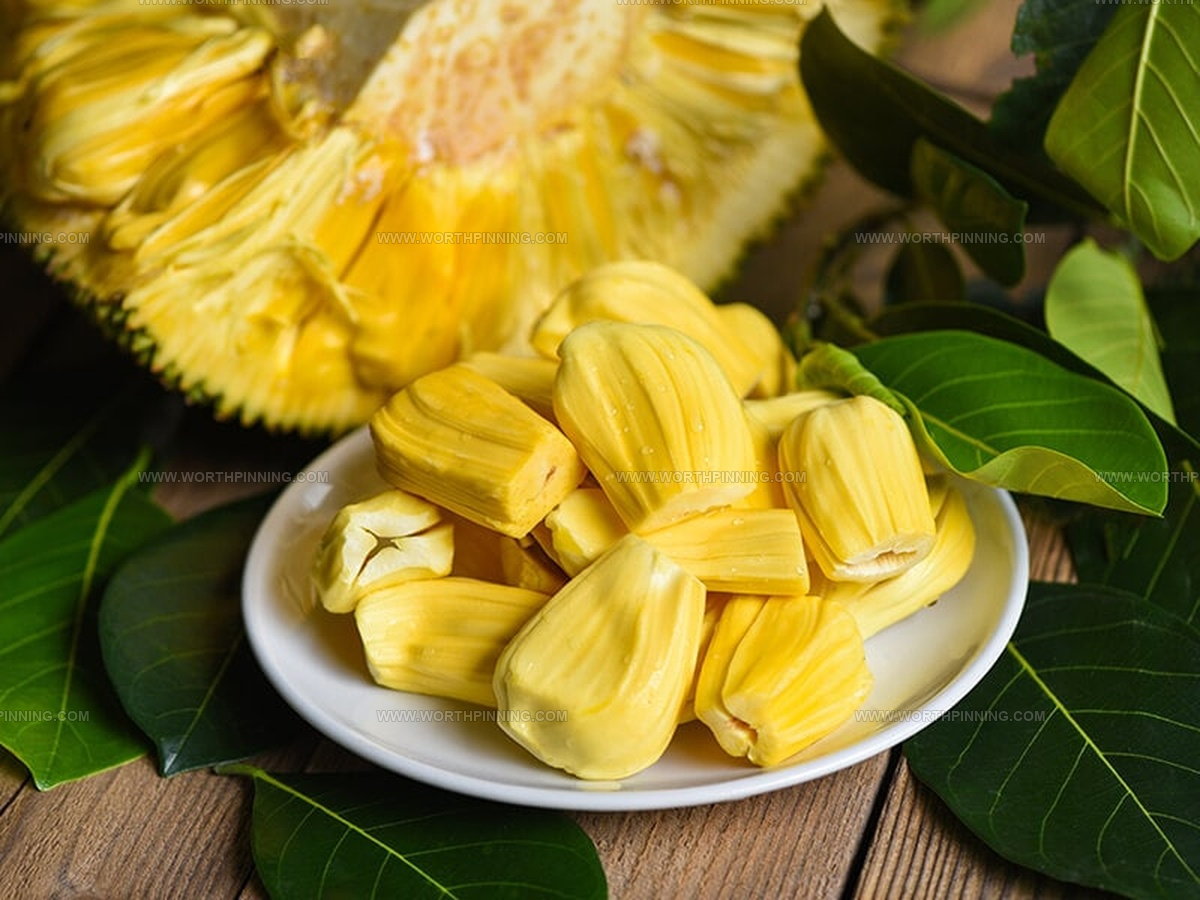
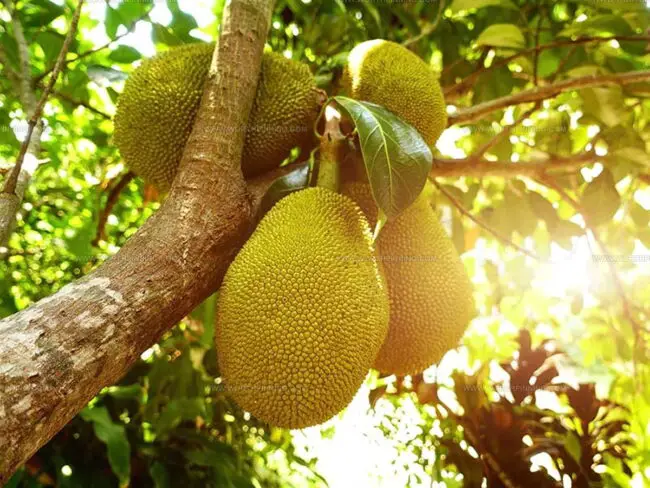
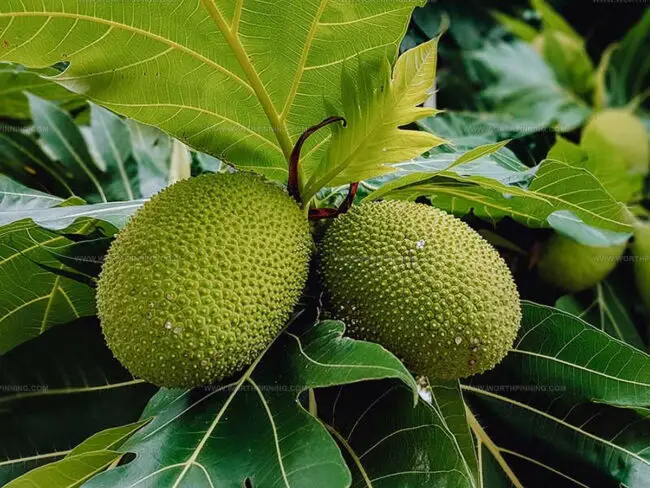
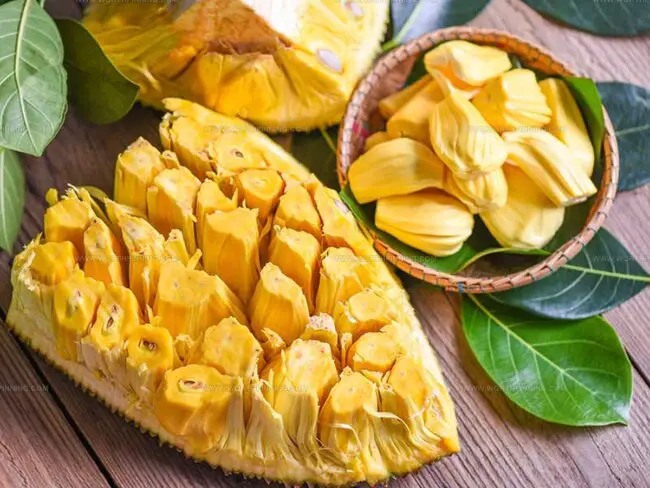
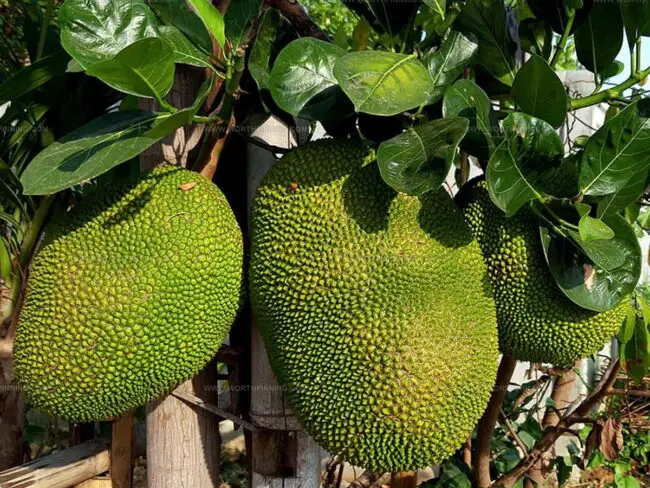
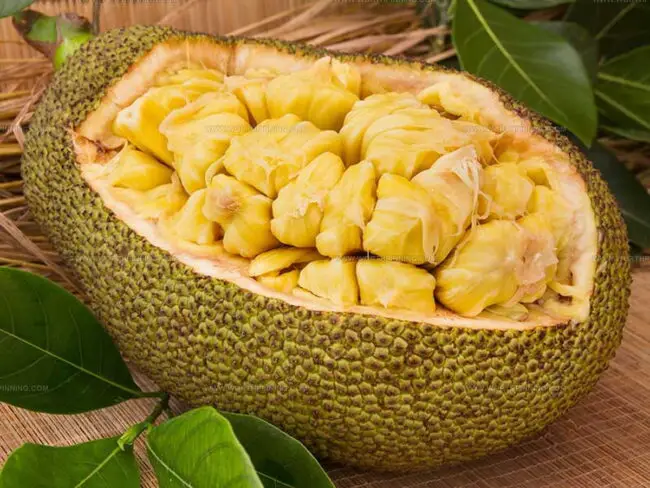

Sophia Rivera
Recipe Developer & Kitchen Tips Specialist
Expertise
Education
Austin Community College
San Antonio Culinary Institute
Sophia’s passion for baking began in her family kitchen, where she spent hours experimenting with new recipes. With a background in baking and pastry arts, she loves making desserts that are as visually stunning as they are delicious.
Sophia is all about using seasonal, locally sourced ingredients to create treats that everyone will enjoy. When she’s not creating mouth-watering desserts, you can find her gardening, making new recipes, or enjoying a relaxing afternoon with her family.